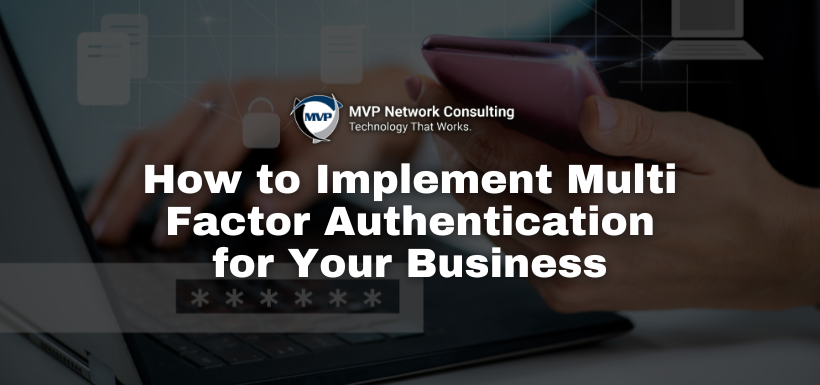How to Choose the Right Cloud Storage Solution for Your Business

Ikram Massabini
July 23, 2025

Cybercriminals aren’t just targeting large corporations. Nearly 43% of all cyberattacks are aimed at small businesses, and most of them succeed by exploiting weak login security.
One of the simplest and most effective ways to strengthen your defense is Multi Factor Authentication (MFA). If someone steals your password, MFA adds a second or even third barrier that stops them in their tracks.
Here’s a step-by-step guide to implementing MFA across your business — so you can secure your systems, protect your data, and reduce your risk.
Why MFA Is a Must for Small Business
A single compromised password can cause serious damage. MFA helps prevent that by requiring more than just a password to log in. It adds another verification step — like a one-time code or fingerprint scan — that only the real user can provide.
Hackers rely on people reusing or guessing passwords. MFA breaks that cycle and blocks access, even when your password is stolen.
What MFA Really Means
Multi Factor Authentication requires two or more forms of identification before granting access. It’s built on a simple but powerful concept — combining different types of verification to prove you are who you say you are.
Something You Know
This is usually a password or PIN. It’s the most common factor, but also the weakest. Phishing, brute force attacks, and leaked credentials can all expose this layer.
Something You Have
This includes physical or digital tools like:
A mobile device for text message codes
A hardware security token or key
An authentication app like Duo, Authy, or Google Authenticator
Even if a hacker has your password, they still need this second factor to break in.
Something You Are
Biometric verification uses your unique traits. This might include:
Fingerprint recognition
Facial recognition
Voice ID
Retina or iris scan
This factor is extremely secure and hard to fake — and it’s becoming more common on business devices.
How to Set Up MFA for Your Business
MFA isn’t difficult to implement, especially with the right plan. Here’s how to roll it out successfully:
Step 1: Audit Your Current Systems
Start by identifying where MFA matters most. Focus on high-risk accounts and applications like:
Email platforms
Cloud file storage
Financial accounts
Customer databases
Remote desktop tools
Start with these core systems, then expand to cover all logins.
Step 2: Choose the Right MFA Tool
There are plenty of MFA options, including free and low-cost tools. Look for one that fits your team and scales with your growth.
Popular options include:
Google Authenticator – Free and easy to use
Duo Security – Intuitive and flexible, with basic free plans
Authy – Offers device syncing and cloud backups
Okta – A more advanced solution with broad enterprise features
Select a provider that supports your software and is easy for your employees to adopt.
Step 3: Roll It Out to Your Team
Start with priority users and expand. Make MFA mandatory across devices and platforms. For remote workers, pair MFA with VPNs or secure access gateways.
Step 4: Train and Support Employees
Not everyone is tech-savvy. Provide easy-to-follow guides, short videos, or one-on-one help so every team member can set up MFA correctly and confidently.
Clear onboarding will reduce frustration and boost adoption.
Keep Your MFA System Up to Date
MFA is not a one-and-done project. Ongoing maintenance and review are key to staying secure.
Update Your Authentication Methods
Consider stronger options like biometrics or push notifications as they become available. Retire outdated or less secure methods like SMS codes when possible.
Reassess Account Access
Business needs change. Periodically review who has access to what, and whether certain systems now require MFA that didn’t before.
Prepare for Lost Devices
If a phone or token is lost or stolen, employees should be able to quickly recover access. Use backup codes, alternative methods, or remote reset options to ensure security and continuity.
Test Your MFA System Regularly
Testing helps you catch problems early and ensures employees follow best practices.
You can run simulated phishing attacks or simply monitor login activity for unusual behavior. This also helps you balance security with user experience — MFA should protect your systems without slowing your team down.
Common Challenges and How to Solve Them
Implementing MFA comes with a few hurdles. Here’s how to overcome the most common issues:
Employee Pushback
Some users may resist change. Explain the importance of MFA and show how easy it is to use. Offer hands-on support and remind your team that MFA helps protect their own accounts too.
Software Compatibility
Not every app supports MFA. Choose providers that integrate well with your current stack, or use single sign-on platforms that centralize access.
Budget Concerns
Start with free tools if needed. Many small businesses find Google Authenticator or Duo’s free plan is enough at the beginning. You can upgrade later.
Lost Devices
Create a clear policy for dealing with lost phones or tokens. Provide alternate recovery methods like backup codes or admin resets to minimize downtime.
Now Is the Time to Act
Cyberattacks are increasing — and small businesses are a prime target.
Multi Factor Authentication is one of the most powerful and cost-effective steps you can take to protect your data. It’s simple to implement, affordable, and can stop most credential-based attacks in their tracks.
If you need help getting started or want expert support on choosing the right solution, reach out to us today.
We’re here to help your business stay secure.
